В этой статье, мы рассмотрим, как настроить сетевой мост на компьютере под управлением Windows. Такой сетевой мост, работающий на канальном уровне модели OSI (L2), используется для прозрачного объединения двух и более сетей в одну общую сеть. Все версии Windows поддерживают объединение сетевых адаптеров в мост, никакое дополнительное ПО не потребуется.
В нашем примере у нас есть компьютер Windows с двумя сетевыми картами, подключенными в два разных сетевых сегмента. WLAN адаптер подключен к Wi-Fi сети (роутер с доступом в интернет), и Ethernet адаптер подключен к изолированной проводной локальной сети (LAN), построенной на коммутаторе. С помощью сетевого моста на Windows-компьютере вы прозрачно объединить две сети и все клиенты из изолированной сети (LAN) смогут получать доступ к ресурсам в основной сети и выходить в интернет через маршрутизатор.
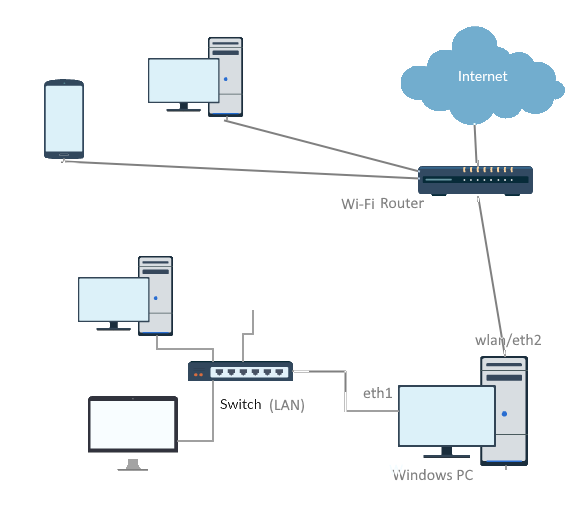
Создать сетевой мост в Windows можно из стандартной панели управления сетевыми подключениями (
ncpa.cpl
). Выберите два (или) более сетевых адаптера, которые вы хотите объединить мост, и в меню выберите Bridge Connections.
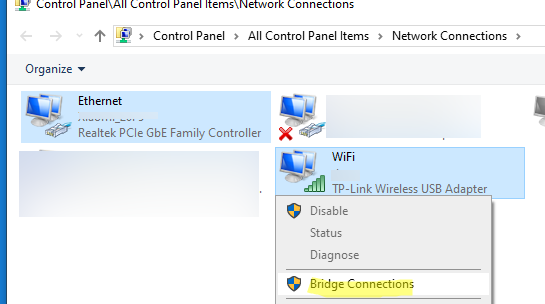
Через некоторое время в списке сетевых адаптеров появится новый сетевой адаптер типа Microsoft Network Adapter Multiplexor Driver с именем Network Bridge.
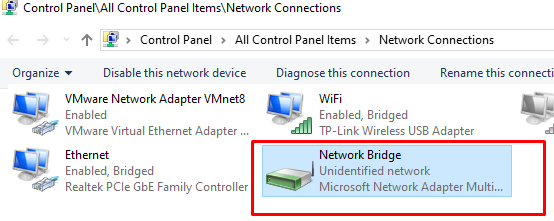
При создании моста может появится ошибка:
An unexpected error occurred while configuring the Network Bridge.
В этом случае откройте свойства бриджа и отметьте сетевые адаптеры, которые должны объединяться вашим мостом.
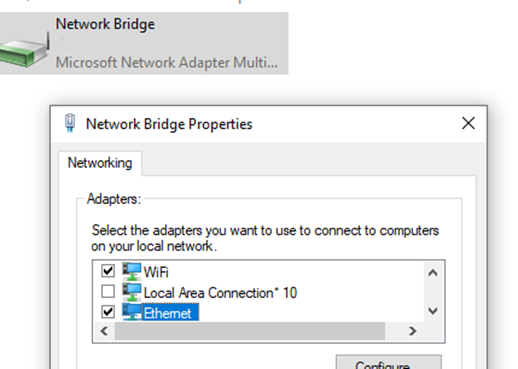
После этого любые участвующих в мосте сетевых адаптеров, включая TCP/IP, станут недоступны для редактирования, а в описании адаптеров появится статус Bridged. Сетевой мост может включать в себя более двух сетевых адаптеров.
Теперь, если на роутере включен DHCP сервер, все клиенты в LAN получат IP адреса из внешней сети (на клиентских компьютерах должно быть включено автоматическое получение IP адресов от DHCP, либо IP адреса из одного сегмента нужно задать вручную). Таким образом вы прозрачно объедините две сети с помощью сетевого моста.
Если в сети отсутствует DHCP сервер, статические IP адреса для интерфейса bridge и на устройствах в объединенной сети можно назначить вручную.
Чтобы удалить сетевой мост, щелкните по немы и выберите Delete.
В старых версиях Windows сетевое подключение типа мост можно было только из графического интерфейса. При попытке выполнить команду
netsh bridge install
появлялась ошибка:
Not supported. Please go to the Network Connections folder to install.

В Windows 11 22H2 после установки кумулятивного обновления от 2023-09, можно создать сетевое подключение типа мост из командной строки с помощью утилиты netsh.
Выведите с помощью PowerShell имена сетевых интерфейсов в Windows:
Get-NetAdapter
Вывести доступные для добавления в мост сетевые адаптеры:
netsh bridge show adapter

Чтобы создать мост из двух интерфейсов, укажите из имена в следующей команде:
netsh bridge create Ethernet1 WiFi
После того как мост создан, получите его GUID:
netsh bridge list

Добавить или удалить сетевой адаптер в бридж:
netsh bridge add <Adapter_Name> to <bridge_guid>
netsh bridge remove <Adapter_Name> from <bridge_guid>
Удалить мост:
netsh bridge destroy <bridge_guid>
При объединении в мост Ethernet и Wi-Fi адаптеров, в Windows бридж работает некорректно, если одновременно оба устройства были отключены от сети, а потом подключены. В качестве обходного решения можно добавить в сетевой мост отдельное устройство, которое никогда не отключается. Проще всего это сделать, создав фиктивный Microsoft loopback adapter (в современных версиях Windows это устройство
Microsoft KM-TEST Loopback Adapter
). Можно создать адаптер из Device Manager или с помощью утилиты devcon:
./devcon.exe -r install $env:windir\Inf\Netloop.inf *MSLOOP
Для организации общего доступа к интернет-подключению в Windows можно использовать службу Internet Connection Sharing (ICS). В этом случае Windows компьютера будет выступать в качестве роутера (уровень L3/L4 OSI), а адреса клиентов буду скрываться за NAT. См. как создать точку доступа Wi-Fi и раздать интернет в Windows.
Suppose you have access to two separate WiFi connections and want your PC to connect to both of them for better internet bandwidth and performance. Doing so may seem difficult or impossible, but you can make it happen on your Windows 10 computer.
In the following sections, we shall look at the methods that will let you connect to two WiFi network connections on Windows 10 computer. These methods are pretty simple to execute; follow the steps carefully, and you will be all set to go.
Table of Contents
How to Merge Two Wireless N Connections in Windows 10
Method 1: Through Load-balancing Router
One of the methods that do not require Windows 10 settings to be tweaked on your PC is through a load-balancing router. A load-balancing router will enable you to use two different internet connections to merge and provide a better internet bandwidth right through your Wi-Fi router. All you need are separate internet connections. You can use the LAN cable of the two internet connections in a single router to transmit Wi-Fi network with enhanced bandwidth and speed.

You can either use two separate connections from a single Internet Service Provider or individual network connections from different Internet Service Providers for this purpose. The LAN wires bearing the internet connection from your ISP(s) should be inserted into the load-balancing wireless router’s input sockets. After attaching the router’s network connections, you will have to carry out a couple of configuration settings.
How to Configure Wi-Fi Router to Bridge two Wireless Networks
To merge (bridge) internet connections on the router, you will need to access the router’s configuration settings page. Although the process is pretty simple, it varies according to the Wi-Fi Routers’ manufacturers.
WiFi Routers have firmware installed in them that lets you configure the device according to our requirements. These settings can be accessed on your PC through a web browser. To make two wireless network connections work together through a router, you will want to load the router’s network configuration page on your computer.
The steps required for this can be easily found on the router’s user manual. If you cannot find the router’s user manual, you can access the same from the manufacturer’s website.
Alternatively, you can also contact your internet service provider and ask them to help you out. Try to get in touch with a technician.
The process for the same can also be found easily on the internet. All you need to do is carry out a Google search regarding the same with the router’s manufacturer name and the model number. For example, perform a google search as Manufacturer name Model Name load balancing.
Once the settings have been applied, you can go ahead and restart your router. After the restart, you will be able to access the wireless network connection with boosted bandwidth and speed.
Note: To merge two wireless network internet on one router, you will need to have a router with load-balancing capabilities. A load-balancing router can merge not just two but more wireless network connections on a single router. You have to make sure how many network connections does a router supports for load-balancing.
Method 2: Through Speedify (third-party software)
Do you have access to two different WiFi networks and would like to use both of them on a single PC. With software like Speedify, you can merge both of them pretty quickly. However, using this feature comes with an additional requirement of connecting new hardware to your computer.
A laptop or PC has just one wireless network adapter by default. This means that it can connect to just a single Wi-Fi internet connection at a time; however, by adding a Wi-Fi network adapter, you can connect to two different wireless networks on your PC. So, make sure to have an external USB Wi-Fi adapter handy.
Your PC must be connected to one of the WiFi networks by default. To connect to another WiFi network, insert the external WiFi dongle adapter into any of your PC’s USB slots. Now, wait till the external device’s adapter is installed. The installation process of the adapter is automatic, so you do not need to do anything.
After installing the adapter, you may have to turn on the second Wi-Fi option using the Settings app.
Press Win + I to open the Settings app. In the Settings app, select the Network & Internet option. Now, on the Settings window, go to the left panel and select the Wi-Fi option. Then, go to the right panel; you will see a Wi-Fi 2 option, enable it through its toggle switch.
After enabling the second Wi-Fi adapter, go to the Windows taskbar at the bottom of the screen. Here, select the Wi-Fi 2 option from the dropdown menu and connect to the second WiFi network connection on your Windows 10 computer through the external WiFi adapter. This has to be the other WiFi network you would like to merge the internet connection with.
When done, open the Speedify software on your computer. If you haven’t installed it, download it first from the Speedify Official Website.
On the Speedify interface, you will see both the WiFi networks that you are connected to. Now, by default, according to Windows 10 settings, your computer will only use the wireless internet connection that is performing better.
Once you have established that your PC is connected to both of the WiFi networks, go ahead and activate Speedify. This will activate the WiFi bridge process. Now, you will be able to access the internet on your PC with a better bandwidth.
To check if the method worked or not, you can check the Speedify interface. Here, you will get all the information that you require about both the WiFi networks, separate, as well as combined. The information available on the interface includes data usage, latency, ping, download speed, upload speed, and the duration of the active connections.
Once you are done using the bridge wifi network connection between the two networks, you can disable Speedify if you want.
Mind you, Speedify is not a free software to use. To unlock its full potential on your PC, you will need to buy the full version. With the unlocked version, you will be able to merge two WiFi networks at a time on your Windows 10 PC.
Conclusion,
Although it is not that difficult to connect two WiFi networks at once in Windows 10, the real problem arises when you have to make both WiFi networks work collectively.
Using a load-balance router is the way to go, but what if your router doesn’t support load balancing. In such a case, using third-party software, such as Speedify, comes into the picture. However, this also requires you to have an additional WiFi dongle connected to your PC. Before merging 2 WiFi network connections on Windows 10, make sure you have all the necessary hardware required for carrying out the process.
Recommended for You:
How to Delete Network Profile in Windows 10
How to Connect Two Computers Using WiFi in Windows 10
How to Remove WiFi Network in Windows 10
How to Fix WiFi Unidentified Network in Windows 10
Solved: Can’t See My WiFi Network in Windows 10
Solved: No wifi Networks Found on Windows 10
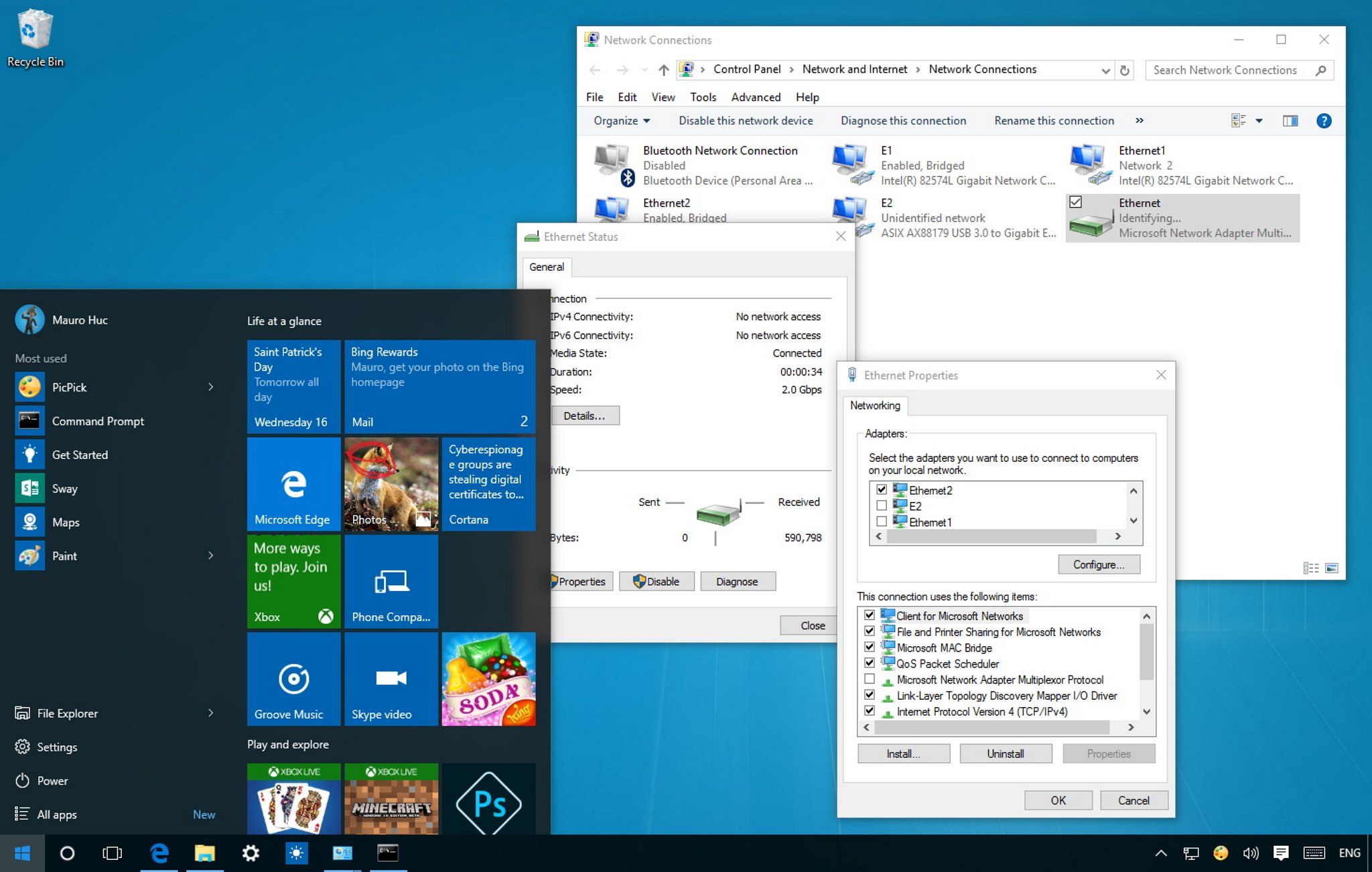
Network Bridge is a feature that has been part of Windows for a long time. A bridge allows you to connect two or more network segments together allowing devices to join the network when it’s not possible to connect them directly to a router or switch.
For example, on an Xbox 360 without a wireless adapter, an Xbox One that no longer connects to Wi-Fi, or when a computer is far away from the router, you can use Network Bridge to share your computer’s connection (e.g., Ethernet or Wireless) with these devices to allow access the network. Once devices connect using a bridge, they will appear as if they were physically connected to the router.
In this Windows 10 guide, we’ll walk you through the steps to properly set up a bridge connection on your desktop or laptop to allow other devices to join your local network and to access the internet.
Before you begin
Before you start setting up a bridge connection on Windows 10, you will need at least two network adapters. One that is connected to the internet and a second adapter that will be used to connect another computer.
Additionally, as a result of setting up a bridge on Windows 10 (or on previous versions of the operating system), the primary network adapter on the host computer will lose internet connectivity.
To regain access to the internet, you will need to set a static IP address to your computer manually. The first thing you want to do is to save to a text file the current IP address information assigned by the DHCP server on your local network.
To get the IP address information from your computer follow these steps:
All the latest news, reviews, and guides for Windows and Xbox diehards.
- Use the Windows key + X keyboard shortcut to open the Power User menu and select Command Prompt.
- Type the following command and press Enter:
ipconfig /all - Make note of the IP address configuration of the network adapter connected to the internet. You need to record the following information: IPV4, subnet mask, default gateway, and DNS servers addresses.
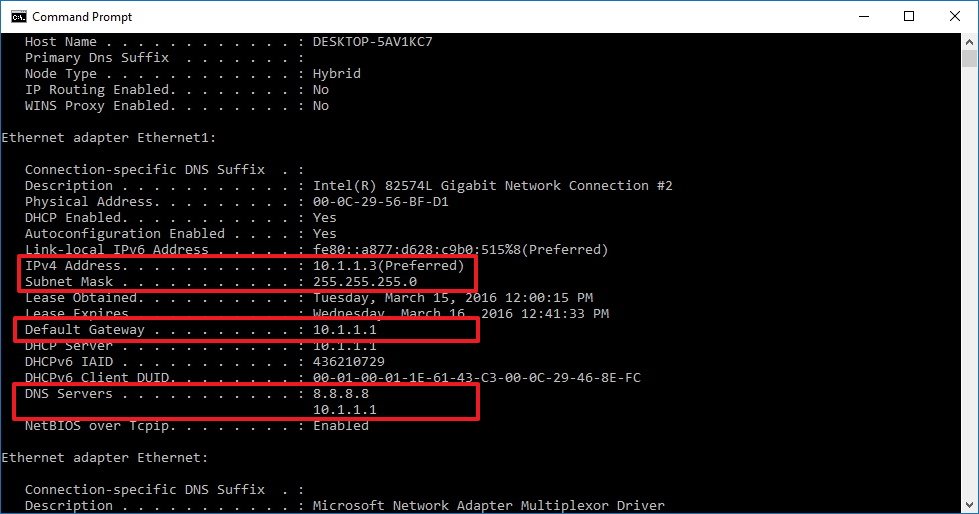
Note: You can use an IP address dynamically assigned by the DHCP server as static only as a temporary solution. On best practice you should assign an IP address in the range that doesn’t belong to the DHCP address pool on your router. For more information on how to find the DHCP server configuration make sure to check your router’s manufacturer support website.
How to create a Network Bridge on Windows 10
- Use the Windows key + X to open the Power User menu and select Network Connections.
- Select both, the network adapter that connects to the internet and the adapter you want to use in the bridge connection.
- Right-click the selection and click Bridge Connections.
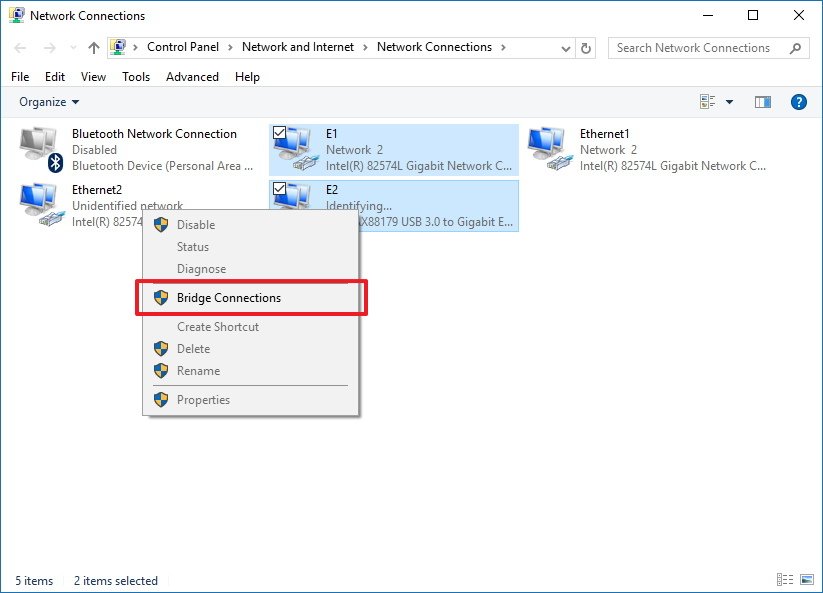
At this point, the device connected to the bridge port should have access to the network and internet with the IP address information coming from the router, but the computer hosting the bridge won’t be able to access the internet unless you have a third network adapter that is also connected to the network or a static IP address .
How to regain internet access after setting up a bridge connection
To regain access to the internet from the host computer do the following:
- Use the Windows key + X to open the Power User menu and select Network Connections.
- Right-click the bridge adapter and select Properties.
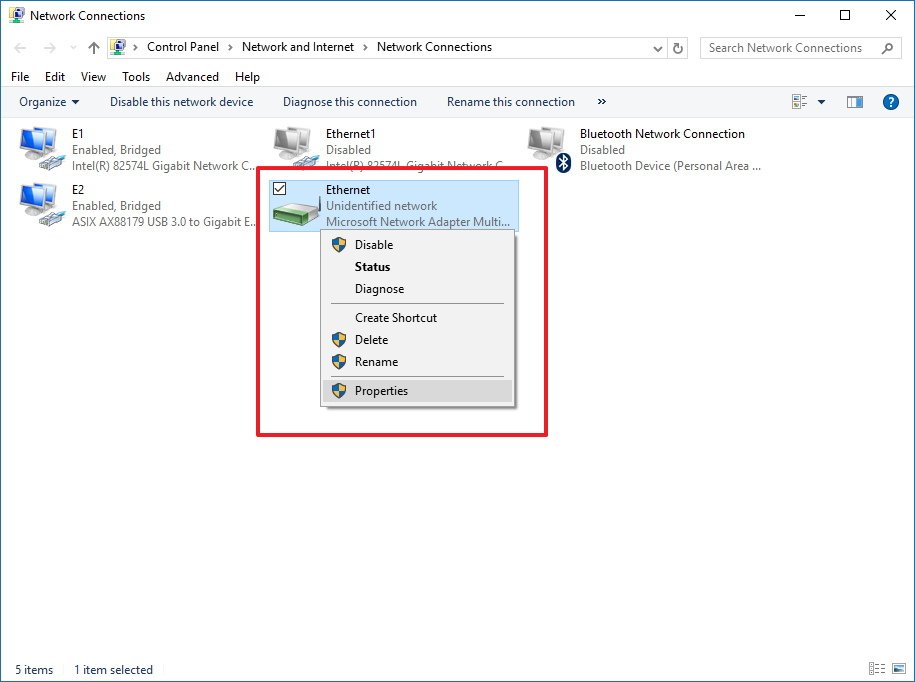
- Select the network adapter that connects to the internet.
- Select Internet Protocol Version 4 (TCP/IPv4).
- Click Properties.
- Select the Use the following IP address option.
- Use the IP address information you collected at the beginning of this guide to assign a static IP address like is shown in the screenshot below.
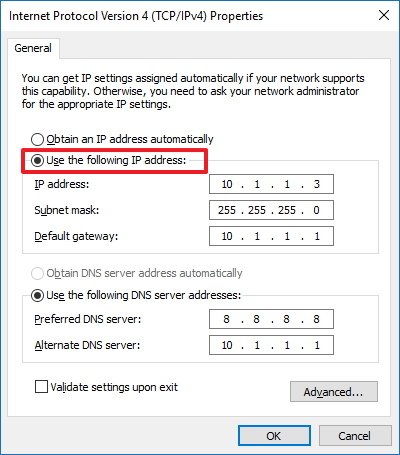
- Click OK.
- Click Close to complete the task.
How to add more network adapters to a bridge connection
You’re not limited only to offer bridge connectivity to a single network adapter. At any time, you can add multiple adapters.
- Right-click the network adapter and select Add to Bridge.
- Connect a game console or another computer and the device will automatically acquire the network settings from the local router.
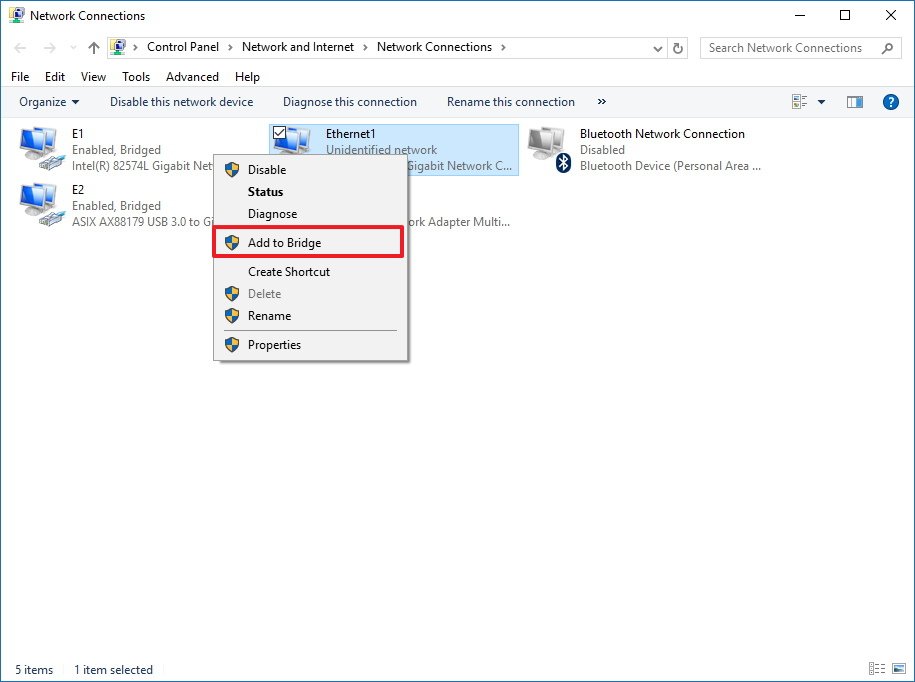
How to remove a bridge connection from your computer
When you no longer need a bridge connection, select one or all the participating network adapters, and select Remove from Bridge.
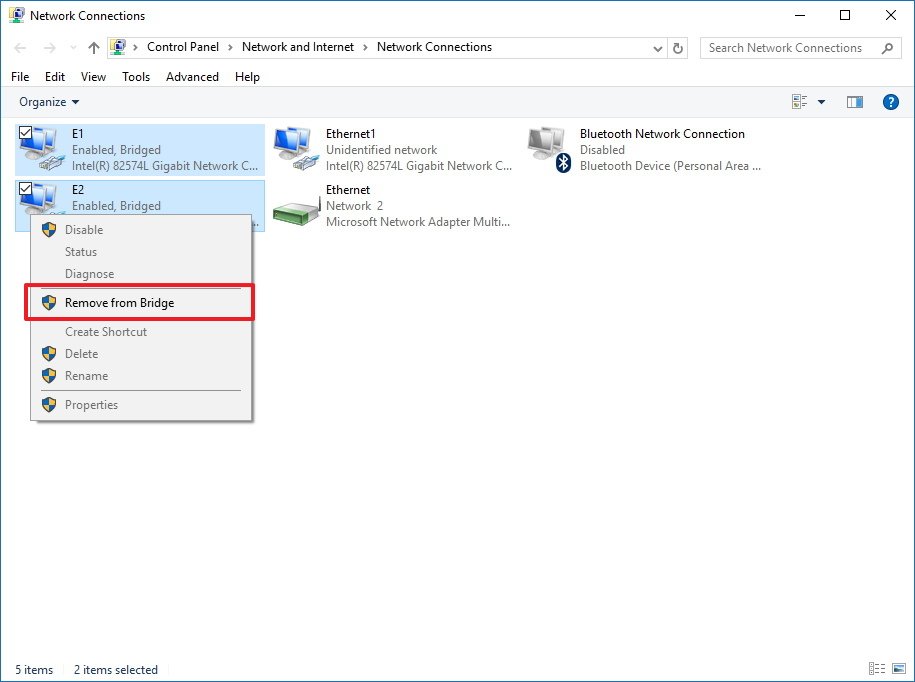
At this point, the bridge adapter should disappear from Network Connections, but if it doesn’t, simply reboot your computer.
The last thing left to do is to remove the IP address static settings and let your PC once again get this information automatically from the router.
- Right-click the network adapter and select Properties.
- Select Internet Protocol Version 4 (TCP/IPv4).
- Click Properties.
- Select the Obtain an IP address automatically option.
- Select the Obtain DNS server address automatically option.
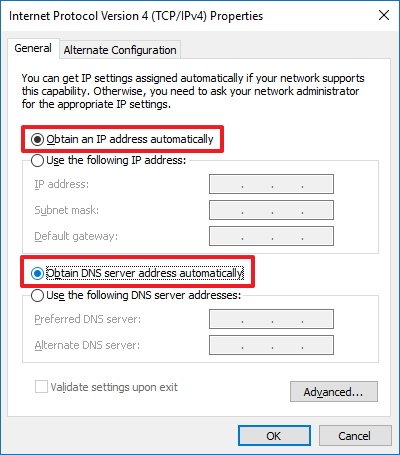
- Click OK.
- Click Close to complete the task.
Network Bridge or Internet Connection Sharing?
It’s important to note that Network Bridge is very similar to the Internet Connection Sharing (ICS) feature, but they’re not the same.
When you use Internet Connection Sharing (ICS), you will convert your computer into a router, which uses a built-in DHCP server to assign IP addresses to computers participating in ICS. It also offers Network Address Translation (NAT) that allows multiple devices to connect to the network using the ICS host as the middle man.
On the other hand, Network Bridge doesn’t turn the host computer into a router and you won’t get Network Address Translation. It only provides a medium (bridge) in which other devices can connect directly to the network and obtain the same IP address scheme every other computer connected to the network is using.
Which feature you should use? The answer to the question is: «depends». Both features offer similar benefits. If your local network already includes a router connected to the internet and you want a seamless network integration where all devices share the same network addressing scheme, then you should consider using Network Bridge.
If you need a router-like feature, and you want to keep the network segments separated while taking advantage of the security benefits of Network Address Translation, then you’ll be better suited using Internet Connection Sharing.
In theory, a bridge connection is more efficient, because the host is only a pass-through, and all the routing process will occur in the local router and not on the host computer.
Remember that Network Bridge and Internet Connection Sharing have been designed only for home and small office networks, and for scenarios, where a wireless connection can’t be established, or a cable run to the main router or switch is not possible. These features are not recommended as networking solutions for businesses. In addition, there can only be one Network Bridge or one Internet Connection Sharing per-computer.
Windows 10 resources
For more tips, coverage, and answers on Windows 10, you can visit the following resources:
- Windows 10 on Windows Central – All you need to know
- Windows 10 help, tips, and tricks
- Windows 10 forums on Windows Central
Mauro Huculak has been a Windows How-To Expert contributor for WindowsCentral.com for nearly a decade and has over 15 years of experience writing comprehensive guides. He also has an IT background and has achieved different professional certifications from Microsoft, Cisco, VMware, and CompTIA. He has been recognized as a Microsoft MVP for many years.
There are a few different ways that you can bridge a connection in Windows 10:
1. Use the Network Connections tool:
Open the Control Panel and click on Network and Sharing Center. Click on Change adapter settings. Right-click on the network adapter that you want to bridge and select Properties. Select the Sharing tab. Check the Allow other network users to connect through this computer’s Internet connection checkbox. Select the network adapter that you want to use for the bridge connection and click OK.
2. Use the Command Prompt:
Open the Command Prompt and type in the following command:
netsh wlan show drivers
This will show you a list of all of the wireless adapters that are installed on your computer. Find the name of the adapter that you want to use for the bridge connection and note the name. Type in the following command, replacing «AdapterName» with the name of your adapter:
netsh wlan set hostednetwork mode=allow ssid=Bridge SSID key=password
Replace «Bridge SSID» with the name that you want to use for your bridge connection and «password» with the password that you want to use. Type in the following command
How do I bridge a network connection in Windows 10?
How do I bridge a network connection?
There are a few different ways to bridge a network connection, depending on your specific needs. If you’re looking to connect two local networks, you can use a network bridge. This will allow you to share resources between the two networks, as well as connect devices that are on different networks. If you’re looking to connect a device to a network that it doesn’t have a direct connection to, you can use a network bridge as well. This will allow the device to connect to the network indirectly through another device that is connected to both networks.
What does bridging a connection do?
Bridging a connection is a process of connecting two or more computer networks together so that they can communicate with each other. This can be done using either hardware or software, or a combination of both.
Can you bridge Ethernet and WiFi Windows 10?
Yes, you can bridge Ethernet and WiFi on Windows 10. To do this, go to the Network and Sharing Center and click on Change adapter settings. Right-click on the Ethernet adapter and select Properties. Under the Sharing tab, check the box next to Allow other network users to connect through this computer’s Internet connection. Then, select the WiFi adapter from the drop-down menu and click OK.
How can I merge two internet speeds faster in Windows 10?
If you have two internet speeds that you want to merge for faster speeds, you can use a tool like Speedify. Speedify is a bonding VPN that lets you combine multiple internet connections at once for faster speeds. To use Speedify, you’ll need to connect each of your internet connections to separate Speedify servers. Once you’re connected, Speedify will automatically balance your traffic across all of your connections for the fastest possible speeds.
How do I bridge two Ethernet ports?
There are a few ways to bridge two Ethernet ports, depending on your needs. If you want to connect two Ethernet-enabled devices to each other and share an Internet connection, you can use a network bridge. This will allow the two devices to communicate with each other as if they were on the same network.
If you’re using Windows, you can create a network bridge by going to the Control Panel, clicking on «Network and Sharing Center,» and then clicking on «Change adapter settings.» Right-click on the Ethernet adapter that you want to use as the bridge, and select «Properties.» Under the «Networking» tab, select the «Internet Protocol Version 4 (TCP/IPv4)» checkbox, and click «OK.«
Right-click on the other Ethernet adapter that you want to use as the bridge, and select «Properties.» Under the «Networking» tab, select the «Internet Protocol Version 4 (TCP/IPv4)» checkbox, and click «OK.«
Now, right-click on the first Ethernet adapter again, and select «Bridge Connections.» This will create a network bridge between the two adapters.
If you’re using macOS, you can create a network
Should I bridge my connection?
If you are using a router to connect to the internet, then you will need to bridge the connection. This will allow the router to connect to the modem and pass the internet connection to your computer. To do this, you will need to login to the router’s web interface and enable the bridge mode.
How do you bridge two interfaces?
In order to bridge two interfaces, you will need to use the bridge command. This will allow you to specify the two interfaces that you want to bridge together. For example, if you wanted to bridge eth0 and eth1, you would use the following command:
bridge add br0 stp_on=1
ifconfig eth0 up
ifconfig eth1 up
brctl addif br0 eth0
brctl addif br0 eth1
Can I combine two Internet connections to get a faster connection?
Yes, you can combine two Internet connections to get a faster connection. There are a few different ways to do this, but the most common is to use a technique called «bonding.» Bonding combines multiple Internet connections into a single «pipe,» which can increase your overall speed.
There are a few things to keep in mind if you’re considering bonding:
1. Make sure your router is capable of bonding multiple connections. Not all routers have this feature.
2. You’ll need two (or more) Internet connections. These can be from the same provider, or from different providers.
3. The speed of your individual connections will impact the speed of your bonded connection. For example, if you have two connections that are each capable of 10Mbps, your bonded connection will be capable of 20Mbps.
4. Not all applications will benefit from a bonded connection. In general, applications that require a lot of data to be transferred (like video streaming or file transfers) will see the biggest benefit.
If you’re interested in bonding your Internet connections, talk to your Internet service provider(s) to see if they offer this service.
Should I bridge my WiFi and Ethernet?
There are a few reasons you might want to bridge your WiFi and Ethernet connections. For example, if you have a device that only supports Ethernet and not WiFi, you can bridge the two connections to give that device internet access.
To bridge your WiFi and Ethernet connections, you’ll need a router that supports bridging (most routers do). Once you have your router, follow these steps:
1. Connect your WiFi router to your modem.
2. Connect your Ethernet device to your WiFi router.
3. Configure your router to bridge the WiFi and Ethernet connections. Consult your router’s documentation for instructions on how to do this.
Once you’ve completed these steps, your WiFi and Ethernet connections will be bridged and your Ethernet device will have internet access.
How do I enable bridge mode?
There are a few steps to enabling bridge mode:
1. Log into your router’s web interface. This can be done by typing your router’s IP address into a web browser.
2. Find the section of the interface that deals with networking or LAN settings.
3. Find the option to enable bridge mode and enable it.
4. Save your changes and reboot your router.
Can I combine 2 internet connections?
Yes, you can combine 2 internet connections by using a router that supports link aggregation. Link aggregation allows you to combine multiple physical links into a single logical link, which can increase bandwidth and improve redundancy.
Can I combine 2 Wi-Fi connections?
Yes, you can combine two Wi-Fi connections by using a Wi-Fi repeater or extender. This will amplify the signal and extend the range of the Wi-Fi network.
Can you bridge 2 Wi-Fi connections?
Yes, it is possible to bridge two Wi-Fi connections. This can be done using a Wi-Fi router or a software-based Wi-Fi hotspot.
To do this using a Wi-Fi router, you will need to configure the router to act as a bridge between the two Wi-Fi networks. This can be done using the router’s web-based interface. Once the router is configured, you will need to connect the two Wi-Fi networks to the router.
To do this using a software-based Wi-Fi hotspot, you will need to install the hotspot software on a computer that is connected to both Wi-Fi networks. Once the hotspot software is installed, you will need to configure it to bridge the two Wi-Fi networks.
Возможно ли реализовать посредством моста следующее подключение: компьютер № 1 с Windows 10 подключен к роутеру через Wi-fi, в LAN порт компьютера № 1 по проводу подключаем компьютер № 2. Нужно, чтобы у второго компьютера был доступ к сети.
-
Вопрос задан
-
12911 просмотров
Пригласить эксперта
Есть 2 пути:
1. Создание новой сети с доступом к основной. Для этого надо зайти в свойства сетевого адаптера Wi-Fi, выбрать пункт «Доступ» и поставить галочку: «Разрешить другим пользователям сети использовать подключение к Интернету данного компьютера». В выпадающем списке выбрать LAN-сетевую карту.
2. Мост между сетями. Для этого нужно выделить два адаптера, нажать правой кнопкой мыши и выбрать «Настройка моста». Всё сразу заработает.
Войдите, чтобы написать ответ
-
Показать ещё
Загружается…
